

0965-B1
Wulf Killmann and Dieter Schöne 1
Jointly with the Intergovernmental Panel on Climate Change (IPCC), the International Union of Forest Research Organizations (IUFRO), the Center for International Forestry Research (CIFOR) and the United Nations Environment Programme (UNEP), the Food and Agriculture Organization (FAO) has started a process to harmonize forest-related definitions, taking into consideration aspects of forest management, forest biological diversity, inventory and remote sensing and climate change. The objectives of the process are to help improve synergy among conventions and international processes, to use scarce resources for assessment, monitoring, reporting and verification more effectively, and to help reduce the reporting burden on countries. The paper reports on the process and its recommendations.
Nearly all global or regional information on forest resources is derived from national data and the authority responsible for aggregating the data has developed definitions appropriate to the purpose for which it is collected. FAO, for example,has the task of collecting global information on the extent and state of forest resources and it has therefore developed forest-related definitions for national inputs to globally aggregated forest assessments and outlook studies. The Parties to the UNFCCC have developed forest-related definitions for use in climate change issues involving land use, land-use change and forestry. Other organizations have developed such definitions for other purposes, such as monitoring biological diversity in forests. The information required differs between users, and countries have to cope with a "reporting burden", having agreed to report to different conventions and processes on various forest-related aspects. In order to contribute towards the reduction of the reporting burden, and to enhance understanding between processes and conventions, a process on harmonizing forest- related definitions has been started.
The aim of this paper is to review the process of harmonisation of definitions that has been under way for the past two years.
Each international convention or process is context-specific and applies its own definitions of forest-related terms. However, the use of these terms and the way they are defined should be as consistent and accurate as possible, independent of purpose. The context specificity of definitions within the different processes and conventions in most cases does not permit a standardization of definitions. What is needed, however, is a harmonization of terms.
Harmonization describes a process where:
The need for such a harmonization was elaborated by the Resumed Sixth Session of the Conference of Parties to the UNFCCC (Bonn, 16-27 June 2001), the Twentieth Session of the FAO Council (Rome, 19-23 June 2001), the FAO Committee on Forestry at its fifteenth session (Rome, 12-16 March 2001), the FAO Committee on Agriculture at its sixteenth session (Rome, 26-30 March 2001) and the first session of the United Nations Forum on Forests (New York, 11-12 June 2001).
The definitions used by the various conventions and processes (e.g. und art. 3.3 and 3.4 of the Kyoto Protocol, or the definitions agreed at Kotka (FAO, 2001) for FAO's Forest Resources Assessment are themselves results of participatory processes.
The harmonization process set in motion was not intended to question decisions taken by Parties to the conventions, neither did it intend to interfere with ongoing processes. Rather, it was to look at the subject from a purely technical point of view, taking into considerations aspects of forest management, forest biological diversity, inventory and remote sensing, and climate change, and thus complementing work done by other bodies and processes, and drawing up options for a possible harmonization of forest-related definitions.
FAO, the Intergovernmental Panel on Climate Change (IPCC), the International Union of Forest Research Organizations (IUFRO), the Centre for International Forestry Research (CIFOR), and in the later stage of the process , also the United Nations Environment Programme (UNEP) jointly started a process to harmonize definitions for core forest- related terms.
The objectives of this process were to improve efficiency of processes in different international policy foras related to forests, to improve the quality and usefulness of forest information, to help increasing the synergy among conventions and international processes,to use more effectively the scarce available resources for assessment, monitoring, reporting and verification, and to help reducing the reporting burden on countries.
To this end, within nine months, two expert meetings were held in Rome. National experts participated in both meetings, but also representatives from NGO's the private sector and important IGO's like UNESCO and ITTO, or the Secretariats of the UNFCCC and the CBD.
In the first meeting convened on January 23- 25, 2002 in Rome the scope of the process, and its further steps were decided. The meeting also agreed upon core and supportive terms to be further discussed. An analytical framework on forest-related definitions was drafted and circulated, and finally discussed at the second meeting held in Rome on September 11-13.
The following conclusions and recommendations arose from the meetings:
1 Before adopting new definitions for widely used terms, consistency with the current use in other fora should be considered.
2 The comparative analytical framework (FAO, 2002) of forest-related definitions between international processes should be developed further. Such a framework, drawing on comparative matrices and set concepts, identifies (i) the presence or absence of various elements or parameters contained in the respective definition (binary concept, e.g. minimum crown cover) and (ii) quantitative Threshold parameters (e.g., 10%). The Land Use- Land- Cover relationship between the forest definition as used by FAO's Forest Resources Assessment and the UNFCCC/ Kyoto Protocol is reflected in figure 1.
3 The meeting also discussed the term forest degradation, as well as the supporting terms forest improvement, forest restoration and forest rehabilitation (figure2). The term includes elements such as stand structure, resilience, functions, time scale, cause, and reference state. The coverage of these elements in the definitions applied by different bodies is depicted in table 1. The two expert meetings have concluded that the differences were minor in the definitions of terms listed below. The meetings identified ways in which the definitions could be further harmonized, or the differences which could be dealt with in relation to:
4 The meeting identified other terms that were used primarily in a regional rather than a global context, and have different meaning from region to region, such as:
5 Since the current definitions of the terms indicated below had certain inconsistencies, the meeting made proposals for new formulations or adaptations. However, it was recognized that some further work may be required to finalize this task through a cooperative effort between the relevant bodies and in cooperation with countries. The terms in question were:
6 A number of "supporting" terms, referring to the condition or quality of forests (figure 3 and 4) would still benefit from an effort towards coining common, broadly accepted definitions. This follow-up work could take place in cooperation with the processes and bodies which have a mandate or an interest in using them. These terms include, inter alia,
7.The meeting made 32 recommendations to the different Conventions, bodies and processes using forest-related definitions on their harmonization (see table 2).
The use of different definitions for a given term impedes understanding between stakeholders. While standardization of definitions would be a way to overcome this problem, it would also make a given definition less sharp. As the present process has shown, definitions are usually objective- and context specific. The way forward to increase a better understanding is a harmonization of definitions. The present paper reflects the first step in a process of harmonizing forest- related definitions, and reach agreements between Organizations and Conventions on how to deal with different definitions for the same term
The results have been presented to and discussed by various international fora, including the Subsidiary Bodies of CBD and UNFCCC, ITTO, COFO and UNFF. It is now up to these bodies to decide on to implement the recommendations. The presentation to WFC is made with the expectation that participants presenting the world's forest community will adopt the concept and recommendations.
It is expected that the multiagency collaboration on this subject will continue. It may be extended to other sets of forest-related definitions, e.g. carbon related forestry terms, and to comparable processes in other languages.
FAO, 2001: Global Forest Resource Asse4ssment 2000, Rome, pp. 363-370);
FAO,2002: Second Expert meeting on Harmonizing Forest-related Definitions for Use by Various Stakeholders, Rome: http://www.fao.org/forestry/fop/fopw/Climate/climate-e.asp.
Figure 1: Land Use-Land Cover Relationship
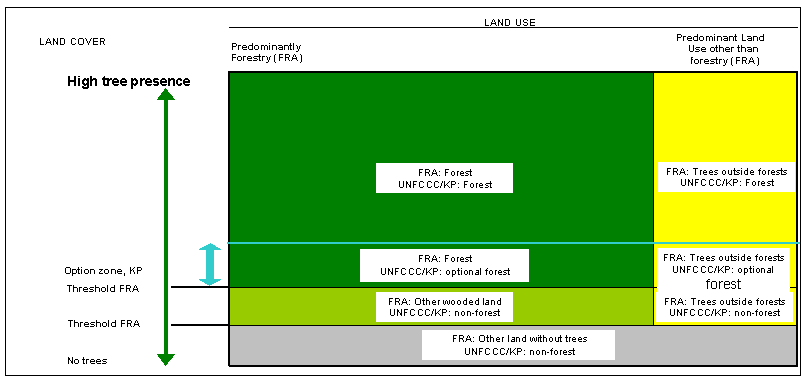
Table 1: Matrix for Forest Degradation
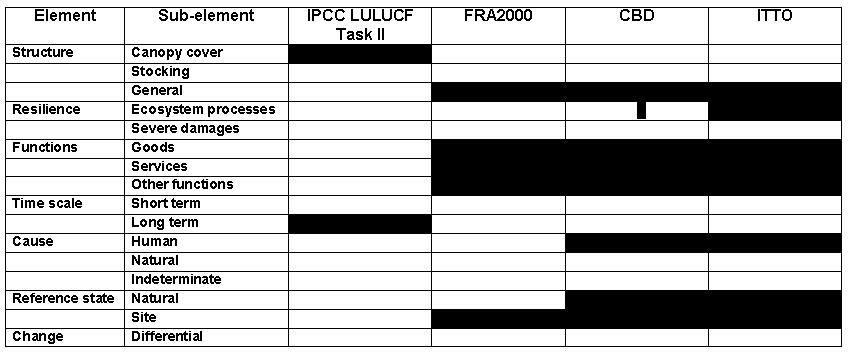
Figure 2: Forest Degradation and supporting terms
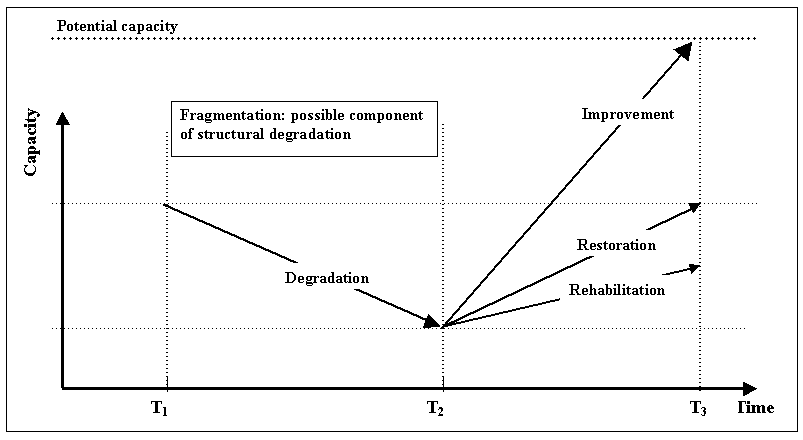
Figure 3: Forest Typology
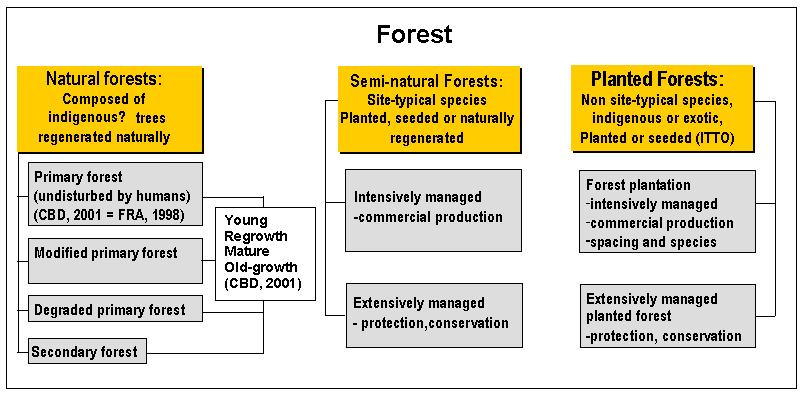
Figure 4: Managed and Unmanaged Forest
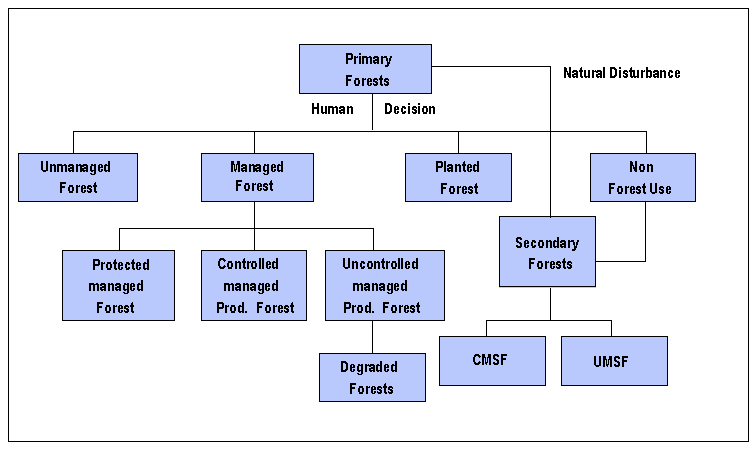
Table 2: Comparative Matrix of Recommendations
CONVENTIONS, BODIES AND PROCESSES MAY TAKE INTO CONSIDERATION THE FOLLOWING OPTIONS SUGGESTED FOR HARMONIZATION | ||||||
TERM |
CBD |
FRA/ FAO |
ITTO |
UNFCCC/IPCC |
COUNTRIES |
ALL |
Forest |
include "temporarily unstocked" areas (13) |
clarify term "predominantly forestry" (24) |
include reference to an established definition of forest (24) |
adopt same threshold parameters for UNFCCC/KP and FRA reporting (1) |
explore need to add additional parameters, supporting terms | |
report separately areas that are "temporarily unstocked" (17) |
replace in all contexts the terms "forest land" and "forested land" | |||||
Non-forest Land |
discuss with other bodies possible introduction of subclasses |
replace through the term "non-forest" | ||||
Other Land |
clarify method of land classification with combined land uses clarify possible subdivision of term in subclasses |
|||||
Afforestation |
further harmonization between UNFCCC and FAO required include assisted generation not involving direct seeding or planting (16) |
remove the requirement for 50- year non-forest condition from second commitment period onwards (30) further harmonization between UNFCCC and FAO required |
||||
Reforestation |
discard the term reforestation (30) |
|||||
Deforestation |
further harmonization between UNFCCC and FAO required |
further harmonization between UNFCCC and FAO required |
||||
Natural Expansion |
add definition of natural expansion to set of definitions (25) |
|||||
Forest Improvement |
Adopt definition: The process of increasing the capacity of forest to provide goods and services (opposite to forest degradation) (3) | |||||
Forest Degradation |
Adopt definition: Forest degradation is the reduction of the capacity of a forest to provide goods and services (6); clarify, if this and the related definitions need qualifiers: |
Adopt definition: |
Adopt definition: Forest degradation is the reduction of the capacity of a forest to provide goods and services (6) |
Exchange terms: distinguish "stock reduction" from "forest degradation". It is still possible to use the same generic definition for degradation and to add qualifiers for monitoring purposes (31) |
||
Forest Fragmentation |
clarify if certain aspects like habitat fragmentation are adequately covered |
Adopt CBD definition: Forest fragmentation refers to any process that results in the conversion of formerly continuous forest into patches of forest separated by non-forest (lands). | ||||
Forest Management |
Adopt definition: FM is the process of planning and implementing practices for stewardship and use of the forest aimed at fulfilling ecological, economic and social functions of forest (19) develop a typology for management objectives (18) |
clarify, if term unmanaged is not superfluous, since there are hardly any unmanaged forests | ||||
Natural Forest |
clarify, whether attribute "indigenous" is necessary, whether "native" (CBD) is fully consistent with term "indigenous" (FRA), and whether the definition should rather refer to "forest stand" than to "forest". |
clarify, whether "native" (CBD) is fully consistent with term "indigenous"(FRA), and whether the definition should rather refer to "forest stand" than to "forest" refer to the natural regeneration of forests and discard the wording "not planted"(20) |
clarify, whether "native" (CBD) is fully consistent with term "indigenous"(FRA), and whether the definition should rather refer to "forest stand" than to "forest" |
|||
Primary Forest |
consider ITTO's definition of "primary forest" (12) clarify, whether the disturbance by non-native animals should be explicitly addressed |
delete in definition of "degraded primary forest" references to primary, old-growth (28) |
||||
Old-growth Forest |
clarify if only limited to primary forest, or includes also secondary and semi-natural forest |
clarify if only limited to primary forest, or includes also secondary and semi-natural forest |
clarify if only limited to primary forest, or includes also secondary and semi- natural forest |
clarify if only limited to primary forest, or includes also secondary and semi- natural forest |
||
Secondary Forest |
clarify if definition should refer to species composition |
develop ITTO definition further: "Woody vegetation regenerated naturally on land that was cleared of its previous forest vegetation" (26) |
clarify if definition should include notion of forest condition resulting from suppression of natural fire regime; | |||
Planted Forest |
include "planted forest" as a separate category (7) discard the attribute secondary in "plantation forest" (11) |
include "planted forest" as a separate category (7) clarify if subclasses are needed to reflect the management objectives and/or whether the species planted occur naturally on the site |
include "planted forest" as a separate category (7) adjust definition to "forest that has been established by planting or seeding" (27) |
|||
1 Director, Forest Products Division, FAO, Viale delle Terme di Caracalla, 00100 Rome, Italy. [email protected]